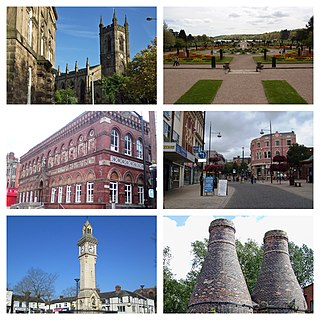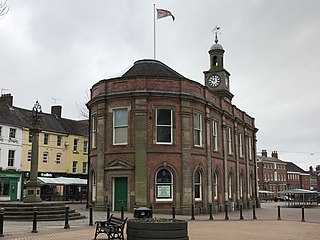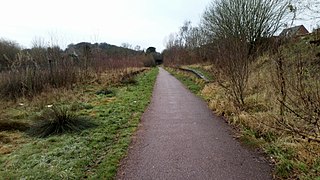
Stoke-on-Trent is a city and unitary authority area in Staffordshire, England, with an area of 36 square miles (93 km2). In 2021, the city had an estimated population of 258,400. It is the largest settlement in Staffordshire and is surrounded by the towns of Newcastle-under-Lyme, Alsager, Kidsgrove and Biddulph, which form a conurbation around the city.

Newcastle-under-Lyme is a market town and the administrative centre of the Borough of Newcastle-under-Lyme in Staffordshire, England. It is adjacent to the city of Stoke-on-Trent. In 2021 the population was 75,082.

The Borough of Newcastle-under-Lyme is a local government district with borough status in Staffordshire, England.

Keele is a village and civil parish in the Borough of Newcastle-under-Lyme in Staffordshire, England. It is approximately 3 miles (4.8 km) west of Newcastle-under-Lyme, and is close to the village of Silverdale. Keele lies on the A53 road from Newcastle to Market Drayton and Shrewsbury. The village is the location of Keele University and Keele Services, a motorway service area on the M6.

Madeley is a village and ward in the Borough of Newcastle-under-Lyme, North Staffordshire, England. It is split into three parts: Madeley, Middle Madeley, and Little Madeley. Madeley Heath is also considered by many to be part of Madeley. In the 2001 census, the population was recorded as 4,386, decreasing to 4,222 at the 2011 Census.

Chesterton is a former mining village on the edge of Newcastle-under-Lyme, in the Newcastle-under-Lyme district, in Staffordshire, England.
Fanny Deakin (1883–1968) was a politician from Newcastle-under-Lyme, Staffordshire, England, noted for her campaigns for better nourishment of young children and maternity care for mothers.

Dilhorne is an ancient parish and village in Staffordshire, three miles from Cheadle and six miles from Stoke-on-Trent. The village is within the Staffordshire Moorlands area.
Leycett was a small mining village in Staffordshire in the Borough of Newcastle-under-Lyme which was built in the late eighteen sixties to accommodate the miners and their families. Population details as taken at the 2011 census can be found under Madeley with the name Leycett meaning 'the clearing in the woods'.
Halmer End is a small village in the Borough of Newcastle-under-Lyme in Staffordshire, neighbouring the small hamlet of Alsagers Bank and the larger village of Audley.
Apedale is a village in Staffordshire, England. The population at the 2011 census can be found under the Holditch (Ward) of Newcastle-under-Lyme.
Outwood Colliery was a coal mine in Outwood, near Stoneclough in the historic county of Lancashire, England. Originally named Clough Side Colliery, it opened in the 1840s and was the largest colliery in the area. It was owned by Thomas Fletcher & Sons, Outwood Collieries, Stoneclough, Manchester. There were two pits. Coal was transported by a tramway to a depot west of Outwood Road, in Radcliffe, and also by tramway through Ringley Wood to the nearby Manchester, Bolton and Bury Canal. A railway sidings from the nearby East Lancashire Railway Line was located nearby, from the northern end of the colliery. In its heyday the colliery employed over 2000 workers. Outwood Colliery exploited the coal seams of the Manchester Coalfield and was noted for its Trencherbone Coal.

The North Staffordshire Coalfield was a coalfield in Staffordshire, England, with an area of nearly 100 square miles (260 km2), virtually all of it within the city of Stoke on Trent and the borough of Newcastle-under-Lyme, apart from three smaller coalfields, Shaffalong and Goldsitch Moss Coalfields near Leek and the Cheadle Coalfield. Coal mining in North Staffordshire began early in the 13th century, but the industry grew during the Industrial Revolution when coal mined in North Staffordshire was used in the local Potteries ceramics and iron industry.
The Minnie Pit disaster was a coal mining accident that took place on 12 January 1918 in Halmer End, Staffordshire, in which 155 men and boys died. The disaster, which was caused by an explosion due to firedamp, is the worst ever recorded in the North Staffordshire Coalfield. An official investigation never established what caused the ignition of flammable gases in the pit.
The Stoke to Market Drayton Line was a railway line that ran through Staffordshire and Shropshire that was built by the North Staffordshire Railway.

Silverdale railway station was a railway station that served the village of Silverdale, Staffordshire, England. It was opened by the North Staffordshire Railway in 1863 and closed to passengers in 1964.
The Holditch Colliery disaster was a coal mining accident on 2 July 1937, in Chesterton, Staffordshire, England, in which 30 men died and eight were injured. It was caused by a fire and subsequent explosions, and was exacerbated by a decision from management to risk the lives of mine workers to try to save the coal seam.
Events from 1998 in England

Cannock Chase Coalfield is a coalfield in Staffordshire, England, lying directly under Cannock Chase. It forms a rough triangle between Brereton, Essington and Pelsall.
The Diglake Colliery Disaster, was a coal-mining disaster at what was Audley Colliery in Bignall End, North Staffordshire, on 14 January 1895. A flood of water rushed into the mine and caused the deaths of 77 miners. Only three bodies were recovered, with efforts to retrieve the dead hampered by floodwater. 73 bodies are still entombed underground.











